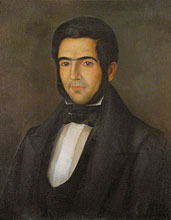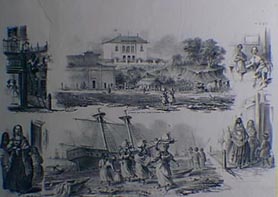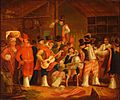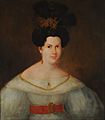Carlos Morel (painter) facts for kids
Quick facts for kids
Carlos Morel
|
|
|---|---|

Portrait in oils c.1838
by Fernando García del Molino |
|
| Born | 12 February 1813 |
| Died | 10 September 1894 (aged 81) Quilmes
|
| Nationality | Argentine |
Carlos Morel (born February 12, 1813 – died September 10, 1894) was an important Argentine painter in the 1800s. Many people consider him the first truly Argentine painter.
Contents
Early Life and Art School
Carlos Morel was born in Buenos Aires on February 12, 1813. His father was a rich Spanish merchant, and his mother was the daughter of a customs official. Carlos's father passed away in 1825. Carlos and his brother Estanislao started working in their father's business when they were young.
In 1827, Carlos Morel began studying art at the University of Buenos Aires. He learned from a Swiss teacher named José Guth. Carlos graduated in 1830 when he was seventeen. He then spent another year learning from an Italian artist, Pablo Caccianiga. One of his classmates was Fernando García del Molino, who later helped him with some of his artworks.
By 1837, people were already calling Morel a promising young painter. He painted many different things, including:
- Portraits (pictures of people)
- Miniatures (very small paintings)
- Genre scenes (pictures of everyday life)
- Battle scenes (pictures of fights)
His first lithograph, a type of print, was made in 1836 and was called The Descent. He became very good at making lithographs. Some of his best works in this style include Buenos Aires Cathedral, Startled Horse, Cuirassiers, and Cavalry.
Time in Brazil
Morel left Buenos Aires on February 22, 1842, and sailed to Rio de Janeiro, Brazil. At that time, Rio de Janeiro was a very exciting place for artists and thinkers. Many artists from France had moved there. The Emperor of Brazil, Pedro II of Brazil, encouraged art and culture.
While in Rio, Morel learned a new technique called daguerreotype. This was an early way to take photographs, invented in 1839. Other important people from Argentina were also living in Rio at this time. Morel made a miniature portrait of his brother-in-law, José María Dupuy, after hearing some sad news about him.
Later Years and Legacy
Carlos Morel returned to Buenos Aires in 1844. In 1845, he published his famous collection of lithographs called "Manners and Customs of the Río de la Plata."
After 1844, his artwork was not as well-known. His painting Combate de los bajíos de Arregui was made in 1848. After that, we don't know of any other artworks by him until 1870.
In 1870, he moved to the home of his half-sister, Indalecia Morel Dupuy de Dupuy, in Quilmes. She had been running a bakery in Buenos Aires. She moved to Quilmes in 1853.
A business directory from Quilmes in 1870 lists Morel as a photographer. Most of the paintings he made in his later years were about religious topics. In 1877, he created an altarpiece for the church in Quilmes.
Carlos Morel passed away in Quilmes, Buenos Aires Province, Argentina, on September 10, 1894. He was 81 years old. The "Carlos Morel School of Fine Arts" in Quilmes is named in his honor. His remains are buried in the town's cemetery.
His Artwork
Carlos Morel painted portraits of many notable people, including Florencio Escardó and Patricio Peralta Ramos. He also made tiny miniature paintings, including ones of General Juan Manuel de Rosas and his wife Encarnación Ezcurra.
He was also known for:
- Scenes of everyday life (genre scenes)
- Battle scenes
- Religious paintings (though these are not considered his best work)
Morel is most famous for his lithographs. His most well-known work is a series of 24 prints called "Manners and Customs of the Rio de la Plata." These were published in 1845 in two books, each with twelve prints.
Morel's prints showed the streets of Buenos Aires, local shops, and the gauchos (cowboys) and other people from early Argentina. Morel was special because he was one of the first Argentine artists to truly capture the spirit of the Pampas region, rather than just showing it like European travelers did.
Gallery
See also
 In Spanish: Carlos Morel para niños
In Spanish: Carlos Morel para niños







